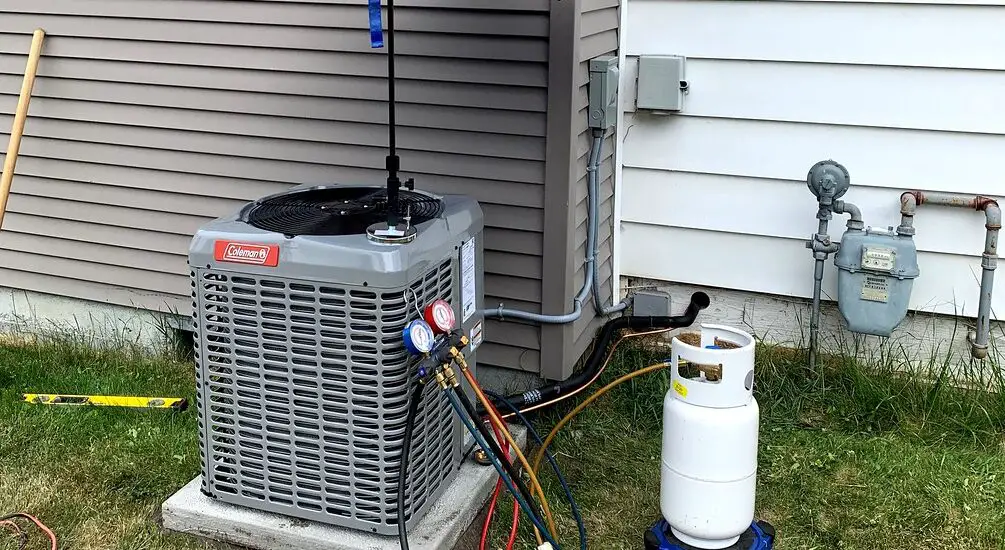The 407a refrigerant is nothing short of a star player in the world of cooling solutions. It’s a unique blend of ingredients offering an array of benefits. We’ll explore its components, wide-ranging uses, and the perks it serves up. Stick with us, and you’ll soon know why this refrigerant isn’t your everyday coolant.

This work is licensed under a Creative Commons Attribution 2.0 Generic License.
Table of Contents
What is Refrigerant 407a?
Composition of 407a Refrigerant
You might be thinking, what makes this refrigerant tick? Well, 407a is a cocktail of three key ingredients: R-32, R-125, and R-134a. These components are mixed together in specific proportions – 20%, 40%, and 40% respectively. It’s a bit like baking, just on a chemical scale!
Physical Properties of 407a Refrigerant
So, what does 407a look like? Imagine a colorless gas that’s pretty much odorless. It has a boiling point of around -44.45°C and a melting point of around -103°C. Sounds like a recipe for one cold customer, doesn’t it?
Applications of 407a Refrigerant
Residential and Commercial HVAC Systems
407a plays a starring role in HVAC systems. It’s like the engine behind the cold air in your home or office. From air conditioning units to heat pumps, 407a does the heavy lifting to keep things chilly.
Refrigeration Systems
Ever stood in a supermarket cold aisle and appreciated how cool it is? Well, chances are 407a was working hard behind the scenes. It’s a top choice in refrigeration systems, from cold storage facilities to transport refrigeration. Keeping your favorite ice cream perfectly chilled? You can thank 407a for that.
Retrofitting with 407a Refrigerant
What about those older systems that used other refrigerants like R-22? Here’s where 407a steps in again. It’s a solid option for retrofitting older systems due to its similarity to R-22 and its superior environmental impact. It’s like giving your old HVAC system a new, greener lease on life.
Efficiency and Performance of 407a Refrigerant
Comparison with Other Common Refrigerants
When matched up against other refrigerants like R-22 and R-410A, how does 407a fare? Quite well, actually! It delivers similar cooling performance to R-22 but with a much lower environmental impact. And against R-410A, 407a holds its own in terms of efficiency. In the battle of the refrigerants, 407a is a tough contender.
Energy Efficiency and Cost Savings
407a isn’t just good for the planet; it’s good for your pocket too. Its high energy efficiency means lower power usage, translating into cost savings over time. It’s like putting money back into your pocket with every cool breeze.
Do you want to get more information about refrigerants? Click here: Articles on Refrigerants: The Ultimate Guide to Understanding Them
Safety and Environmental Impact of 407a Refrigerant
Safety Considerations
Handling 407a needs care. Though generally safe, it can displace oxygen in high concentrations, which is a risk. As long as you handle it with due diligence, you’re good to go.
Environmental Impact and Regulations
And the environment? 407a scores quite well there too. Its ozone depletion potential (ODP) is zero and its global warming potential (GWP) is significantly lower than many other refrigerants. This places it squarely within current environmental regulations, a nod to a cooler future for us all.
Frequently Asked Questions about 407a Refrigerant
Can 407a be mixed with other refrigerants?
Not a good idea, mixing refrigerants can lead to system inefficiencies and is often against manufacturer recommendations.
How to handle 407a refrigerant safely?
Always ensure adequate ventilation, use appropriate protective equipment and follow safety guidelines while handling it.
What is the working pressure of 407a refrigerant?
Working pressures can vary but it generally operates at a higher pressure than R-22.
How does 407a impact the environment?
With its zero ODP and lower GWP compared to other refrigerants, 407a is a friendlier choice for the environment.
Conclusion
407a refrigerant is more than just a cooling solution. Its unique composition, myriad applications, and impressive efficiency make it a standout choice. In an era where understanding refrigerants is key to managing environmental impact, knowing about 407a is a cool asset.
